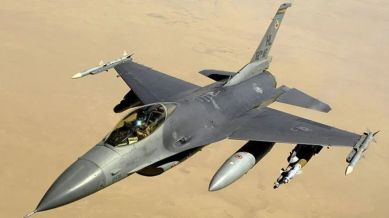Stay updated with the latest - Click here to follow us on Instagram
Russia shoots down F-16 jet: 5 things to know about the staple in NATO’s arsenal
Almost four decades since its introduction, the F-16 is far from being shelved, with approximately 2,600 still in service today between the US and at least 24 of its foreign military partners.

A Ukrainian F-16 fighter jet supplied by the West was shot down in what marked Russia’s largest aerial assault since the three-year-long war began. NATO reportedly scrambled its own warplanes owing to the intensity of the strikes.
On Sunday, Russia launched a total of 537 aerial munitions, including 477 drones and decoys, and 60 missiles, according to the Ukrainian Air Force. The F-16 pilot, Lieutenant Colonel Maksym Ustymenko, born in 1993, shot down seven air targets before he was killed in action.
monthly limit of free stories.
with an Express account.
Here are five things to know about the F-16, a staple in NATO’s arsenal:
1. What is the F-16?
A bulwark of the US Air Force during the Cold War, the fourth-generation multirole fighter was introduced in 1978 and inducted into service in 1979 with the delivery of the F-16A, its single-seater variant. Designed by General Dynamics, the ideation for the aircraft began with an order placed in 1972 for a lightweight, cost-effective air-to-air fighter. Its two-seat model, the F-16B, has tandem cockpits and is used for training.
The F-16C, another single-seat variant with improved avionics and weapons capabilities, entered service in September 1984; and its two-seater counterpart joined in 1978. Lockheed Martin formally became involved with the F‑16 program in 1993 with the acquisition of General Dynamics’ Fort Worth aircraft production division.
2. What are its features?
The single-jet aircraft can fly at Mach 2 (twice the speed of sound). And due to its high G-force maneuvering capabilities, wide combat radius, and its ability to detect and engage enemy aircraft in all weather conditions, it remains a formidable force in air combat.
The jet has also been used extensively for air-to-surface roles throughout its career, with the most recent being Operation Rising Lion, when Israel conducted air strikes to cripple Iran’s nuclear and military infrastructure and chain of command. It was also used during Operation Desert Storm, notably for the bombing of Iraqi military bunkers, which led the US to a decisive victory.
3. Which countries have the F-16?
According to an official US government website, more than 4,600 F-16s have been built so far. Almost four decades since its introduction, the aircraft is far from being shelved, with approximately 2,600 still in service today between the US and at least 24 of its foreign military partners.
The other countries include Bahrain, Egypt, Iraq, Jordan, Morocco, Israel, Oman, Turkey, the UAE, Belgium, Denmark, Greece, the Netherlands, Poland, Romania, Slovakia, Indonesia, Pakistan, the Republic of Korea, Singapore, Taiwan, Thailand, and Chile.
The Pakistani Air Force reportedly operates 75 F-16s, and in 2022, the Biden administration provided Islamabad with a $450 million package “for sustainment and related equipment” of the fleet.
4. Which operations were the F-16s used in?
The F-16 has been extensively used during major conflicts, including the Cold War and the War Against Terror. NATO forces conducted airstrikes over Serbia during the Kosovo conflict in 1999.
F-16s were heavily deployed in the coalition’s campaign in Afghanistan under Operation Enduring Freedom following the 9/11 attacks. It was also used in Operation Inherent Resolve in 2014 against ISIS.
5. Evolution Over Decades
Although fifth generation fighters F-22 and F-35s have become the flagbearers of American air superiority, the F-16 remains a mainstay in NATO’s arsenal, bolstered by upgraded variants. The latest model, the F-16 V (Viper), which was introduced at the 2012 Singapore Airshow, includes advanced AESA radars, new cockpit displays and enhanced avionics, according to Lockheed Martin. In 2019, Taiwan ordered 66 F-16Vs in the backdrop of China’s growing naval influence. With the procurement in progress, the island nation will have more than 200 of these fighters, making it the largest Viper fleet of the F-16 in Asia.
The previous report of F-16 to be shot down in the Russo-Ukrainian War was on April 12. Ukraine received its first batch of F-16 fighter jets during the conflict in August 2024, after NATO pledged to deliver 65 units in 2023, according to the BBC.